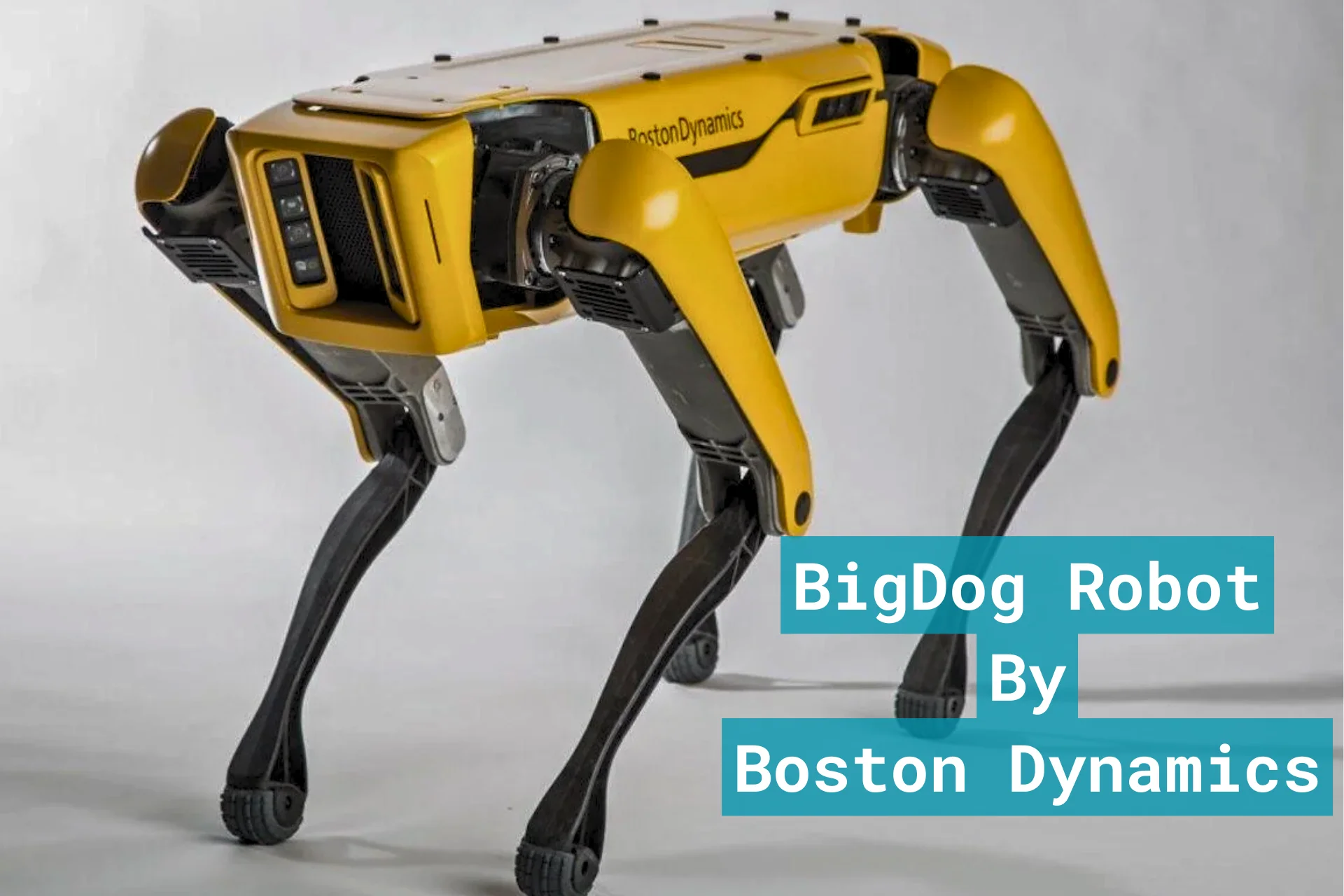Robotics has always been an exciting field, constantly pushing the boundaries of what is possible with technology. However, one particular robot has captured the imagination of the world with its impressive capabilities and lifelike movements – BigDog. Developed by Boston Dynamics, this four-legged robot has revolutionized the way we think about legged locomotion in robotics. In this article, we will explore the history, design, features, and implications of BigDog, showcasing the latest advances in robotics technology.
Introduction to BigDog Robotics
BigDog is a quadrupedal robot designed for rough terrain. It stands at 3 feet tall, weighs 240 pounds, and can carry up to 340 pounds of payload. Its four hydraulic legs are powered by an advanced internal combustion engine that drives a hydraulic pump, which in turn powers the robot’s movements. The robot also includes onboard sensors and cameras that provide it with real-time data about its environment, allowing it to navigate and adapt to different terrains.
The development of BigDog was a significant milestone in the field of robotics. It was the first time a robot had been designed to mimic the movements of animals, specifically a mule or a large dog, in such a lifelike manner. This made BigDog stand out from other wheeled robots that were limited to flat surfaces and could not navigate uneven terrain. Let us now take a closer look at the history of BigDog and how it came to be.
Development and History

The story of BigDog can be traced back to the early 2000s when Boston Dynamics received funding from the US Defense Advanced Research Projects Agency (DARPA) for the development of advanced robotic systems. DARPA’s goal was to create a robot that could assist soldiers in carrying heavy loads over long distances and navigating challenging terrain. This led to the creation of the Legged Squad Support System (LS3) program, with the aim of developing a robot that could carry 400 pounds of gear over 20 miles.
Under the LS3 program, Boston Dynamics began working on BigDog, which was initially called the “Rough Terrain Support Robot.” The team’s goal was to create a robot that could walk like an animal, using biomechanical principles to achieve stability and balance. However, the development of BigDog was not without its challenges. The early prototypes faced numerous issues, including difficulty in controlling the robot’s movements and maintaining balance.
But the team persisted, and after years of research and development, BigDog finally made its debut in 2005. The first video of this impressive robot went viral, gaining attention from both the public and the military. Subsequently, Boston Dynamics continued to improve and refine the robot’s design, resulting in several iterations and upgrades over the years.
Technical Specifications and Features

BigDog’s most noticeable feature is its four legs, each with three degrees of freedom and a total of twelve joints. This allows the robot to move in a manner similar to an animal, providing it with enhanced flexibility and agility. The robot’s legs are also equipped with sensors and actuators, allowing it to make precise movements and adapt to varying terrains.
The robot’s power source is an advanced internal combustion engine that drives a hydraulic pump, powering the robot’s movements. This system provides BigDog with enough power to carry heavy loads while maintaining its balance and stability. In addition to its legs, BigDog also has onboard sensors, cameras, and other instruments that enable it to perceive and interact with its surroundings.
One of BigDog’s most impressive features is its ability to maintain balance, even when faced with obstacles or slippery surfaces. It uses a combination of sensors, software algorithms, and mechanical systems to adjust its movements and maintain stability, much like a real animal. This allows BigDog to navigate through rough terrain, climb steep slopes, and even recover from slipping or being pushed.
Key Innovations and Breakthroughs
BigDog’s development has been a series of breakthroughs and innovations in the field of robotics. Its lifelike movements and impressive capabilities have challenged traditional ideas about how robots should move and interact with the world. Some of the key innovations include:
- Dynamic Balance: One of the most significant achievements of BigDog is its ability to maintain balance while walking on uneven terrain. This requires complex control and coordination of its legs, body, and sensors, which were made possible by advanced software algorithms and mechanical systems.
- Legged Locomotion: BigDog was among the first robots to use legged locomotion, imitating the movements of animals to achieve high flexibility and adaptability. This approach proved to be more efficient than wheeled robots when navigating rough terrain, as seen in the robot’s ability to traverse rocks, snow, and steep inclines.
- Biologically-Inspired Design: The team at Boston Dynamics took inspiration from nature for BigDog’s design, studying the biomechanics of animals and how they move to create a robot with similar abilities. This biologically-inspired design not only resulted in a lifelike robot but also opened up new possibilities for future developments in robotics.
- Payload Capacity: BigDog’s internal combustion engine and hydraulic pump provide it with enough power to carry heavy payloads, making it an ideal assistant for soldiers on the battlefield. This was a significant achievement in robotics, as previous robots were limited to carrying lighter loads or had to rely on external power sources.
- Terrain Adaptation: With its onboard sensors and cameras, BigDog can perceive and understand its environment, allowing it to adapt its movements to different terrains. This remarkable capability enables the robot to walk through mud, snow, and even water, making it an ideal tool for military operations in diverse environments.
Applications in Various Industries
BigDog’s unique design and capabilities have made it an invaluable tool in various industries, including the military, search and rescue, and exploration. Some of the applications of BigDog include:
- Military Operations: The primary purpose of BigDog was to assist soldiers in carrying heavy loads over challenging terrain. Its ability to navigate through rough terrain and carry heavy payloads has made it an essential asset for military operations.
- Search and Rescue: In disaster situations, where humans may have difficulty accessing certain areas, BigDog can be used as a search and rescue robot. Its ability to traverse uneven terrain and withstand extreme conditions make it an ideal choice for these situations.
- Exploration: BigDog’s adaptability and endurance make it an ideal choice for exploration missions, such as surveying remote or hazardous locations. The robot’s ability to carry equipment and navigate through rugged terrain makes it perfect for exploring unknown territories.
Comparisons with Other Robotics Technologies
BigDog’s unique design and abilities have set it apart from other robots, making it one of the most advanced creations in the field of robotics. However, it is not the only robot designed for legged locomotion. Let us compare BigDog with some other notable robotics technologies:
| Robot | Number of Legs | Maximum Payload | Terrain Adaptability |
|---|---|---|---|
| BigDog | 4 | 340 pounds | Rough Terrain |
| Spot | 4 | 30 pounds | Urban Environments |
| Cheetah | 4 | N/A | Flat Surfaces |
| Mini Cheetah | 4 | N/A | Flat Surfaces |
As seen in the table, BigDog stands out with its impressive payload capacity and terrain adaptability, making it more suitable for military and exploration purposes. On the other hand, Spot, another robot from Boston Dynamics, is designed for urban environments and can carry lighter payloads. Cheetah robots have similar legged locomotion abilities but are limited to flat surfaces, while Mini Cheetahs are primarily used for research and educational purposes.
Challenges and Limitations
Despite its impressive design and capabilities, BigDog still faces some challenges and limitations. Some of these include:
- Power Consumption: BigDog’s internal combustion engine and hydraulic system consume a significant amount of fuel and require frequent refueling, limiting its endurance in the field.
- Noise Level: The robot’s engine produces a considerable amount of noise, which may not be suitable for certain applications, such as stealth operations or search and rescue missions where hearing is essential.
- High Cost: The development and maintenance cost of BigDog is relatively high, making it less accessible for smaller companies or organizations.
- Limited Speed: While BigDog can carry heavy loads, it moves at a slower pace compared to other wheeled robots, limiting its efficiency in time-sensitive operations.
Additionally, BigDog’s design is not suitable for all types of terrain. It may face difficulty navigating through dense vegetation, crossing large bodies of water, or climbing extremely steep inclines.
Future Prospects and Potential
BigDog’s development has opened up new possibilities and sparked further advancements in robotics technology. Its lifelike movements and adaptability have pushed the boundaries of what we thought was possible with robots. Some of the potential future developments and prospects for BigDog include:
- Improved Endurance: Researchers are continually working on improving BigDog’s endurance by developing more efficient engines and power systems. This could extend the robot’s operating time and make it suitable for longer missions.
- Advanced Sensors: As sensor technology continues to evolve, we can expect BigDog’s sensors and cameras to become more advanced, providing the robot with enhanced perception and interaction with its environment.
- Customizable Payloads: With advancements in materials and technology, it is possible that future versions of BigDog may have customizable payloads, allowing it to carry various equipment or tools depending on its intended use.
- Integration with Artificial Intelligence (AI): The integration of AI could make BigDog more autonomous and adaptable, allowing it to handle unexpected situations and make decisions without human intervention.
Furthermore, as BigDog’s design principles are studied and refined, we can expect to see other types of robots designed for specific purposes. This could include robots with different numbers of legs, varying sizes, and specialized capabilities, tailored for specific industries or tasks.
Conclusion and Final Thoughts
BigDog has undoubtedly revolutionized the field of robotics, paving the way for further advancements and innovations. Its development showcases the potential of biologically-inspired design and legged locomotion in robotics, opening up new possibilities for robots to interact with the world like living creatures. While there are still challenges and limitations to overcome, BigDog’s impact on the industry cannot be denied. As we look towards a future where robots play an increasingly significant role, it is safe to say that BigDog will continue to inspire and influence the latest advances in robotics technology.
